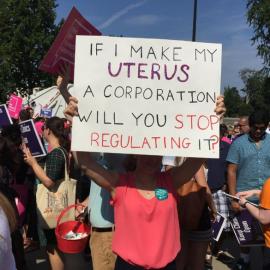June Surprise: Whole Women’s Health v. Hellerstedt Upholds Abortion Rights Against Restrictive Texas Law

Whole Women’s Health v. Hellerstedt is a consequential decision, although far from a decisive victory for abortion defenders. Hellerstedt strikes down a Texas law that would have made legal in-state abortion in practice all but unobtainable for poor and rural women. The decision contains a number of surprises that will hearten supporters of reproductive rights. Surprise number one is that the swing justice, Anthony Kennedy, contributed the fifth vote. Kennedy is hardly a reliable supporter of abortion rights; but with his vote the Hellerstedt majority would have been secure even if Justice Scalia had lived to cast his reliable anti abortion rights vote.
Justice Stephen Breyer wrote the majority opinion. In it he hugs the 1992 Supreme Court precedent, Planned Parenthood of Pennsylvania v. Casey. That decision “saved” Roe v. Wade, then endangered by the large conservative majority on the Court. Only two justices were prepared to leave Roe untouched. A troika of more moderate conservatives led by Justice O’Connor and backed by Justices Kennedy and Souter (before Souter’s move to the left) wrote the controlling opinion. They came up with the Casey formula that retained the fundamental right to abortion but allowed states more scope to regulate (cut back) abortion. States could regulate even during the first trimester of pregnancy as long as regulation did not unduly burden the right to choose abortion.
The surprise in Hellerstedt is that almost nothing had been held to unduly burden the right to abortion despite 25 years in which hundreds of restrictive laws were passed, all designed to stop women from getting abortions. State legislatures hostile to abortion have passed a wide and ever expending assortment of restrictive laws, including informed consent provisions, waiting periods, parental notification, and many laws much like those in Texas House Bill 2 piling onerous requirements on doctors and clinics under the guise of protecting maternal health. H.B.2 was held to unduly burden the right to choose abortion.
H.B. 2 boasts two aggressive health measures, demanding that doctors providing abortion have admitting privileges at local hospitals and that abortion facilities be equipped and regulated as “ambulatory surgical centers.” When the first of these measures went into effect in 2013, 20 of the 40 abortion clinics in Texas closed. Were the second to be permitted to enter into force, only seven or eight abortion clinics, all in major population centers, would remain in this vast and populous state. Texas is one of at least 20 states with laws similar to H.B.2. All of these laws are now in peril of constitutional challenge.
Justice Breyer handed another surprise to Texas and other anti abortion state legislatures: He sided with the district court and against the Fifth Circuit Court of Appeals in holding that federal courts must scrutinize the evidence presented by the contesting parties as the whether the legislation in question burdens the fundamental right to abortion. He rejected simply deferring to the legislature. Texas got caught short. It did not expect this scrutiny and had no evidence that the H.B.2 measures would protect maternal health. (“Trust me”) The petitioning abortion providers had a wealth of evidence that H.B.2 was a catastrophic burden on the ability of women, poor and rural women in particular, to exercise their right to choose. Breyer had no difficulty concluding that when weighed in the balance H.B.2 unduly burdened the right of women to choose with no offsetting gain in maternal health.
It has been widely noted that Justice Breyer’s opinion is merely workmanlike, no poetry, no ringing phrases, as might be expected to adorn an important opinion repurposing Casey as a bulwark against the worst state legislative assaults on the reproductive rights. Workmanlike it is, but Breyer’s discussion of the evidence of the impact of H.B.2 is a devastating unmasking of what the Texas legislature has done and is prepared to do to poor and rural women.
Hellerstedt throws the fight over abortion back into the state legislatures where it has largely been since Roe v. Wade. Roe had not prevented anti-abortion forces from pursuing restrictions through state legislatures even before Casey diluted Roe. In 1980, long before Casey, the Supreme Court held that Roe was not violated when congress denied public funding for abortions for poor women. The federal government and a large majority of states do not fund abortions through Medicaid programs. We will know that the fight for reproductive rights is robust when public funding is a seriously contested question.
Texas and her sister red states will respond to setbacks under Hellerstedt by relentlessly passing new restrictive legislation designed to test the limits of this new Casey-with-teeth, let’s-see-some-evidence approach. Red state legislators have every incentive to keep generating restrictive laws and to defend those already on the books – money, votes, publicity—and in addition to these positive incentives to fear being primary’d from the right. Only popular mass state-by-state campaigns in favor of reproductive rights can defeat these state laws.
It would be a great thing if Bernie Sanders progressives who heed his call to contest state and local elections were to elevate reproductive rights to the top of their issues list and invigorate state level campaigns to repeal restrictive laws. The Sanders campaign reveals what any reader of polls knows, that public support for abortion rights and so much else has failed to register gains for lack of effective forms of political organizing rather than lack of resonance. Few prospects are more satisfying than would be the sight of red state legislators running for cover from reproductive rights activists with mass support.